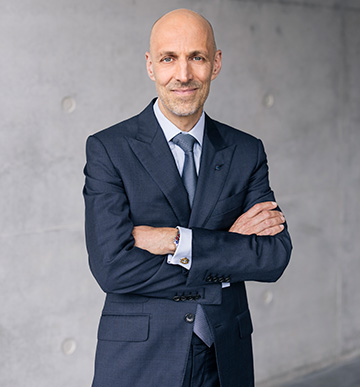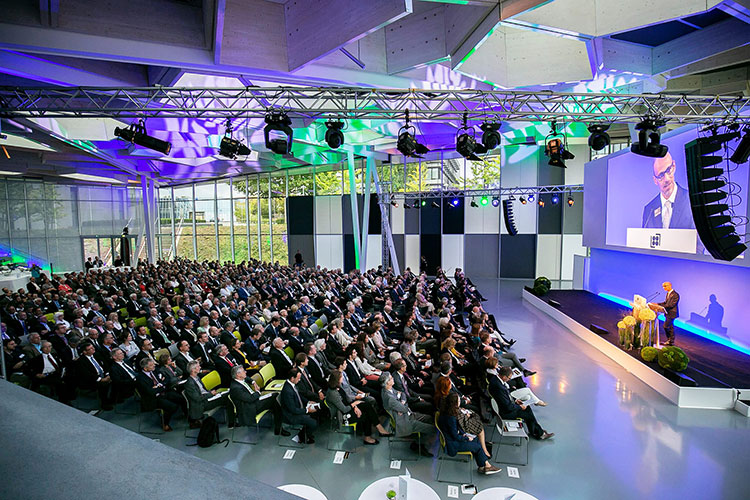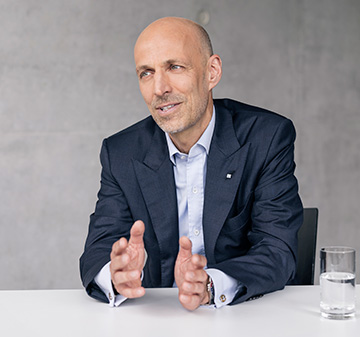
Peter Leibinger. [Image: Trumpf Group]
OPN recently had the opportunity to talk with Peter Leibinger, a key figure at the laser and machine-tools giant Trumpf Group. After years as the company’s chief technology officer, Leibinger recently moved to a new role as chair of its supervisory board, which oversees the firm’s strategic planning. But Leibinger also has a full schedule outside of his work with Trumpf, as head of the Berthold Leibinger Stiftung, a wide-ranging charitable foundation established by his parents in 1992 that, among many other activities, bestows two significant prizes in laser science and technology. (Note: An edited version of this interview appears in the January 2024 issue of Optics & Photonics News.)
Let’s start with your transition to a new role at Trumpf, as the chairman of the supervisory board. How did that come about?
Obviously, this was not a spontaneous decision, but something that I had been thinking about for quite some time, and we had been talking about in the family for some time. There were a number of reasons for this wish to step down from an operational role sooner than usual.
First, there are personal reasons. I had been on the management board of Trumpf for almost 25 years, which is a fascinating position, but also one that takes a lot of strength and concentration—more so, I believe, in a family business, where there are multiple roles that you have simultaneously. I was at a point where I could imagine a life without quite so much constant discipline. So one reason, simply, was less stress.
The second was more time for other things. Like my sisters, I have lots of interests—I’m very interested in research and technology, but also in the arts, literature, photography. And on the side I’m doing a lot of philanthropic work, and I thought it would be nice if I could spend a little more time on that.
“The opportunity to focus more on the strategy part was a very attractive perspective for me.”—Peter Leibinger
Another reason was the question of the transition and succession planning, which both I and my sister [Nicola Leibinger-Kammüller, the CEO of Trumpf] believe are very important aspects of governance for a family business. My transition into the different role is part of our long-term succession plan. And finally, if you look at the role of the board, its role is in oversight and strategy. And the opportunity to focus more on the strategy part was a very attractive perspective for me.
You mentioned your philanthropic activities. You’re the chairman of the Berthold Leibinger Stiftung, which was launched by your father when you were just in your 20s. How did that venture get started?
If you look at the starting date, 1992, it was a very crucial time in German history—just after reunification. And it was, I guess, also a time when my father started looking back, having reached age 62. But also, interestingly, it was still a time when my parents really had very little in liquid assets. Because, of course, the story of the Leibinger family and Trumpf is that of a 40-year management buyout. My parents started acquiring shares of the company in 1962, first through the swap of patents for shares and then, in tranches, buying the company, a process that my two sisters and I completed in 2003.
So my parents had always had to pay down debt, as long as I can think, and that was still the case in 1992. But I think at that time, my parents also felt eternally grateful for the life they had. They had experienced the war; my father was 15 when the war ended. And they had experienced the rise of Germany—both the economic recovery of the country, and its re-acceptance within the group of nations. Added to that was my father’s personal success story at Trumpf. My parents always felt that giving back to society beyond what we pay in taxes is important.
That’s really how this idea of the foundation started. The idea was to give their giving a structure and substance, in the sense that the foundation would be part owner of the company. Over the years we have expanded that to a 10% shareholding of the company by the foundation—inspired, not in a very ideological way, by the tenth of one’s income one is supposed to give according to the Bible.
The Berthold Leibinger Stiftung cover a huge range of areas—it’s not just laser science; it’s cultural and church activities and social-welfare activities. What, if any, are the common threads?
“My parents also felt eternally grateful for the life they had. They … always felt that giving back to society beyond what we pay in taxes is important. That’s really how this idea of the foundation started.”—Peter Leibinger
There are two explanations. One is very personal one. If you look at the topics—science, church, culture and social equity—these were my parents’ topics. Jointly, they were very interested in culture and church. My father was much more interested in church as an institution and a cultural force, whereas my mother was very faithful. They were both highly interested in culture, in the arts, in literature, painting, sculpture, architecture—that was a constant thing in our house. Science, of course, was my father’s big theme. And the social equity, especially relating to children, was my mother’s big thing. So that’s, so to speak, the emotional, the “heart” part. This is why our second foundation, the Doris Leibinger Stiftung, has a strong focus on children's health.
On the other hand, when my father started the foundation, he said, “Let’s make this as broad as possible, because I don’t know what’s going to happen in the next 50 or 100 years with this foundation. And we don’t want the foundation to be limited in its ability to act.”
Therefore, the scope was rather broad. And how we deal with that in the foundation today is by defining fairly specific tasks for each field. The science part, to a large degree, is the Innovationspreis and the Zukunftspreis, and some very specific research projects which we support. Same in the culture and the church. In the church part, for instance, what we support is the conservation and restoration of church buildings, especially in the southwest German region Württemberg. So there we take the grand scheme, and then we really focus it to certain things. Because otherwise, you have no impact.
What sets the Innovationspreis and Zukunftspreis apart from others?
As always, there’s also a history to that. Originally it was just the laser prize, now called the Innovationspreis. And at that time, when it was first started, there really weren’t any laser prizes that focused on the laser application or the industrial implementation of the laser … The Innovationspreis really was my father’s wish to give a prize to something that is an innovation in both the scientific and the market-entry aspects of that. That had to do, of course, with his own history. When he started working with lasers, they were still scientific tools not really suited for industry. The success of Trumpf today still is to take something that really has scientific origins, and make it usable in industry.

Peter Leibinger at the podium at a Leibinger Foundation awards ceremony. [Image: Berthold Leibinger Stiftung]
The Zukunftspreis really came about almost as a coincidence. In 2006, one of the Innovationspreis applicants, H. Jeffrey Kimble from Caltech in the United States, came, and his topic, which was cavity quantum electrodynamics, was just so fascinating. My father went into the jury meeting and listened to what they were saying. And then he decided on the spot, we have to give a prize to Kimble. And so the Zukunftspreis was created, for research on the application or generation of laser light.
This proved to be really valuable, because it broadened the scope of what we look at with the laser prizes. It gives us the ability to reward fundamental work that has changed our industry—as we did with Gérard Mourou in 2016, with Anne L’Huillier in 2023, or with others.
I can’t help but ask about the annual comic book prize that you’ve been giving since 2014. How did that come about?
This prize goes back to my father and my sister Nicola. I think it had to do with a fantastic book, Maus, by Art Spiegelman, which is a comic book about concentration camps. All of us in our family read this and were fascinated by it, and recognized through it that the comic is a powerful language that is completely underestimated. We elevate this genre to the level that it deserves.
This is something that not only does good but, I believe, reflects positively on the foundation. At the end of the day, we’re also in a business with the foundation; if the foundation is not recognized as being high quality, its impact will be much lower. If you come up with something like the comic book prize, where you do something truly unique—it will help the comic genre, but it will also help the foundation.
Let’s talk a bit about the future. The foundation had its 30th anniversary in 2022. What are your priorities for it going forward?
Right now, we’re in a phase of really developing the foundation into something even more impactful. As part of that, we have decided to do fewer small projects. At this point we have a very “long tail” of projects with a couple thousand euros here and there and there. We are now asking, okay, where can we have an even clearer focus than before?
“Right now, we’re in a phase of really developing the foundation into something even more impactful.”—Peter Leibinger
One aspect of that is to team up with other foundations, where you do something jointly that has a larger impact than you could have alone. One such project is the Exilmuseum, or Exile Museum, in Berlin. There is a site in the former East Berlin, the Anhalter Bahnhof, that was one of the major train stations in the city, and that is destroyed; there are only a few fragments left. And as it happens, most of the deportations out of Berlin in the Nazi era left at the Anhalter Bahnhof.
This is the initial thought for a new museum that will be built there. The museum will talk not only about the deportations of Jews and other people to concentration camps, but also about the question of exile and refugees around the world. Our foundation is going to be a major contributor to this Exile Museum because we think it’s a very important topic of the day. Yes, it’s a historical problem—but it’s also a topic going into the future.
That’s a pretty good example for the type of projects that we want to do in the future—larger projects, more in cooperation with others. And we’re also looking at trying to have a little more impact with our social efforts. One in which we have been successful is locally in the hospice movement. The children’s hospice in Stuttgart was established with the help of my mother’s part of the foundation. And we are looking for more examples of that type on the social side.
Turning now to the future of technology, which I know is a topic of great interest to you. I’m curious where you think the laser in particular is going to have its biggest impacts in the future.

Peter Leibinger. [Image: Trumpf Group]
For me, it’s absolutely fascinating to see that the laser today is as “up to date” as it was 30 years ago; we seem to be at the cusp of very, very interesting new developments. And the breadth is astounding—from quantum technology to nuclear fusion. For the first time in history, we are able to control quantum effects, especially the properties of individual photons, with the highest precision and reliability. We have been doing this in the lab for some time, of course, but now we are really thinking about and developing actual products that will go into day-to-day tools. That’s an incredible thing.
And then on the other end, of course, laser-driven nuclear fusion is also something that might happen. And we’re involved in all of these things with Trumpf. So I’m very optimistic that our company will have a lot of work in the future, because the breadth of applications is so incredible.
Is there anything you would mention that is an important scientific or business trend for Trumpf we should watch for in the years ahead?
One topic that I personally find fascinating—even though it’s probably, in the beginning, just a niche market—is laser-driven secondary radiation sources. These are using the laser to generate other types of radiation, be it electromagnetic radiation like X-rays, but also particle radiation by accelerating electrons or even heavier particles such as protons or neutrons. In that context, the laser can be the engine for diagnostic and treatment tools for medical applications in the future, as well as for materials science.
“One topic that I personally find fascinating—even though it’s probably, in the beginning, just a niche market—is laser-driven secondary radiation sources.”—Peter Leibinger
And the idea is that whereas today, very few people have access to these types of research tools, using lasers to create secondary sources could make these tools available in every larger laboratory in a company. It’s going to take a long time, but it can become a very important market and important tool for science, industry and medicine in the future.
I think that laser fusion is especially interesting for us, because you need very high-power lasers for that—and if we participate in the development of these lasers, we will definitely learn things for high-energy laser technology that is also useful outside of the fusion industry.
In the shorter term, the electrification of mobility and also of other industries is a huge field for laser applications, in the making of these products. I think we can play an important role and also make a good contribution. A second large field that is developing, really stemming from EUV lithography, is Trumpf being a supplier to the toolmakers of the semiconductor industry. We’re not supplying the chipmakers directly, but we supply toolmakers with very important subsystems such as laser sources and plasma generators for dry etching or coating processes.
The last thing I would mention is automation on the machine tool side—thinking broadly. Not just something like, a picking mechanism that picks parts out of the machine or loads sheets into the machine, but automation as a merged software and hardware environment that really changes the way sheet-metal parts are being produced. This has already started to be a fundamental growth engine for our company, and I think it will become tremendously important because of all the things that we know about, such as demographic changes and the lack of skilled labor.
I think we were very lucky to recognize this trend early on. We started working on this, fundamentally, 10 years ago. And it is now becoming real and is only going to grow over the next years.
One final question regarding the foundation. I know you can’t “play favorites,” but I’m curious whether there were any things that the foundation has done that really stick out as especially meaningful to you personally.
They’re all great. But to me, personally, I think the celebration of the laser—the Innovationspreis and Zukunftspreis—is really tremendous. Because yes, the prize is good, and it recognizes the people. But what we achieve is to get the world of that technology into one room and to celebrate together. I know of no event that is comparable, at least not in the laser field or in photonics.
And the other I mentioned—I personally also am involved in the hospice, both the normal hospice, where people of all ages are guests, as well as the children’s hospice. And that’s an incredible thing. It does so much for the people who are the guests and for their relatives. Of course, the foundation didn’t do this; others had the idea, and there are many hospices around the world and in Germany. But to be part of this, to be a small part of this, is incredibly valuable for us.
